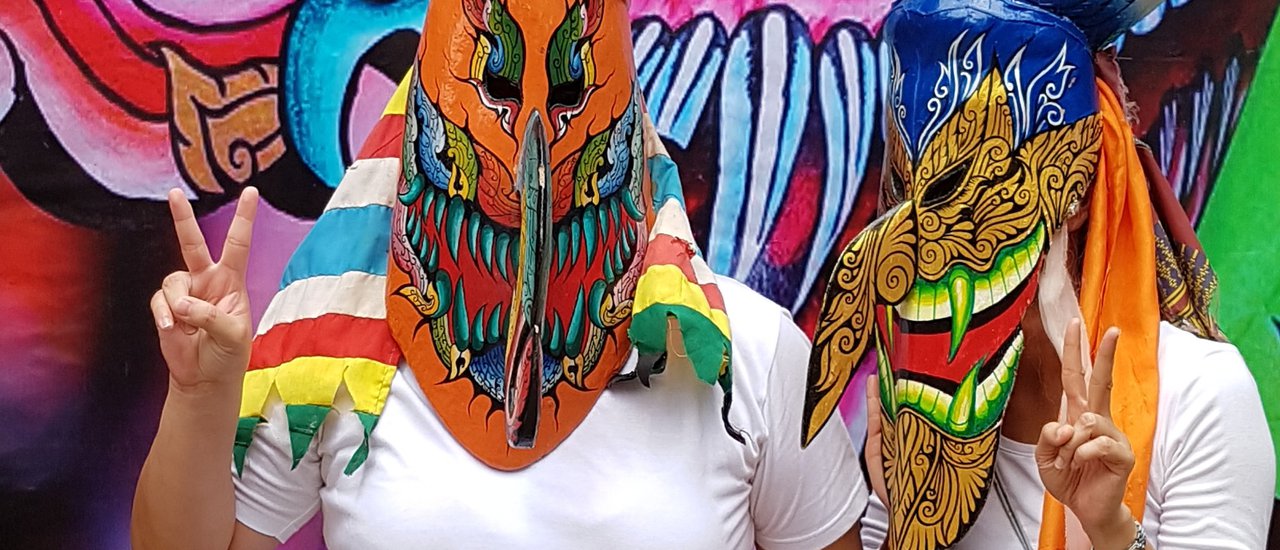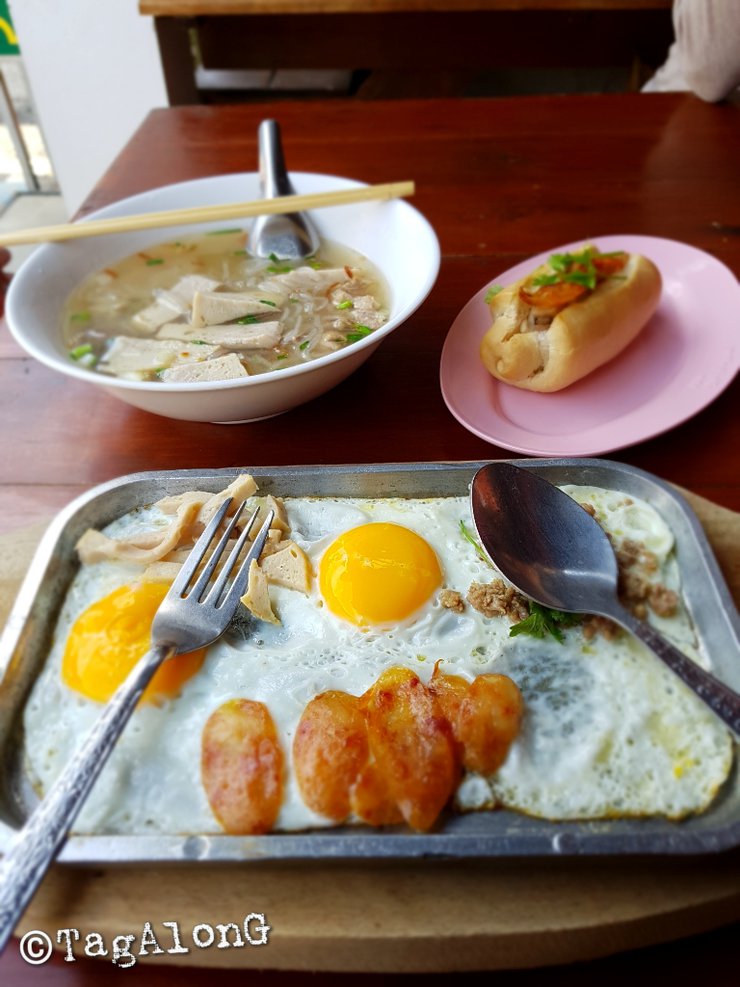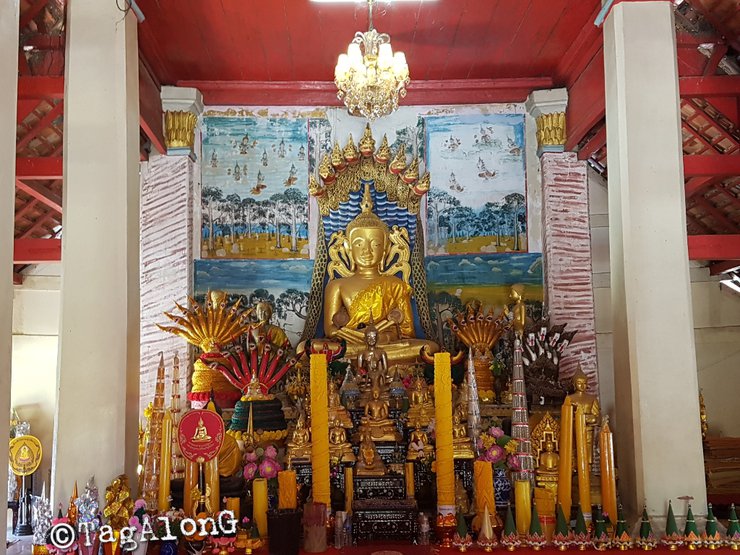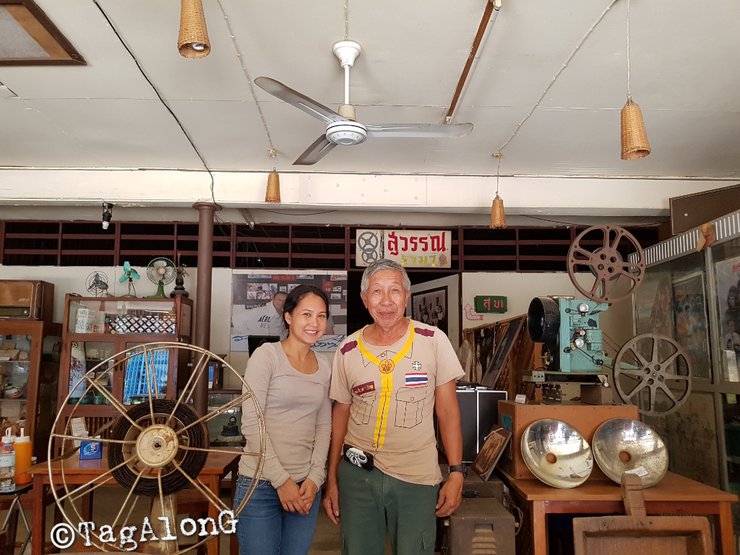Several years ago, we were invited to speak about Thai traditions to students in Singapore. We were given the task of finding something new and different to present, something other than the usual Loy Krathong or Songkran festivals. After much deliberation, a friend from Isan suggested we talk about the Phi Ta Khon festival. This became the starting point for our research into this festival, even though we had never actually seen it ourselves. We gave a fairly good presentation, but deep down we felt a bit ashamed that we had made it seem as if we had actually been there and seen it firsthand. So, when we returned to Thailand, we decided to find an opportunity to see the Phi Ta Khon festival for ourselves. Since we were already planning a trip to Dan Sai, we decided to add a visit to Chiang Khan, which is not too far away. We traveled by bus from the Mo Chit bus station, leaving at 10 pm and arriving in Chiang Khan via Loei town around 8 am the next day. As soon as we got off the bus, we were surrounded by tuk-tuk drivers asking where we wanted to go. However, our accommodation was not far away, so we decided to walk. One of the tuk-tuk drivers gave us his phone number in case we needed to rent a car for sightseeing. When we arrived in Chiang Khan, the atmosphere was very quiet, with hardly any tourists around. Many guesthouses and homestays had signs saying they had rooms available, so we could have easily walked in and chosen a place to stay. However, we had already booked a room in advance at Baan Mui Fang, which is located on the banks of the Mekong River. We wanted to be able to sit on the balcony and watch the sunset. As it was still too early to check in, we left our bags at the guesthouse and went to have breakfast. Our first meal was a delicious pho and fried egg.


After lunch, we visited Wat Si Khun Muang, also known as Wat Yai, which is located near our accommodation. This temple exhibits a blend of Lanna and Lan Chang architectural influences and was constructed in 1942. It is a historic temple that has been an integral part of Chiang Khan for centuries. The tiered roof of the ancient ordination hall immediately caught our attention. We were particularly struck by the statues of giants and lions guarding the foot of the stairs. Their slender bodies, giant stature, and monkey-like faces were captivating, despite the peeling paint. The gable is adorned with wood carvings and stained glass. Above the entrance to the ordination hall, an old mural depicts contemporary objects such as a tuk-tuk, indicating recent renovations. Inside the ordination hall, we saw a golden Buddha statue in the Lan Chang style in the posture of subduing Mara.



After visiting the temple, we borrowed bicycles from our accommodation to explore the city. The weather was hot, so we stopped for a drink at Suwanna Rama Coffee, a former cinema that has been converted into a cafe. The cafe is decorated with old movie posters, cinema seats, and a large film projector. Several rolls of dry, brown film are hung on the walls, and there are photos of the owner with old and new actors and singers. The owner told us that the building was originally a variety theater that changed hands several times before he took over the cinema business in 1970. He proudly stated that Suwanna Rama Cinema could hold over 300 people. The seats were long benches where people sat close together, and the price was the same for both the lower and upper floors. However, drinks were not allowed on the upper floor to avoid spills on the heads of the audience below. Later, the cinema was upgraded with wooden folding chairs with armrests, arranged in rows of 7 seats each. Movie tickets ranged from 3 to 10 baht for adults. Children could watch for free if they performed a song, dance, or other talent for the owner. A show was considered successful if it earned 1,000-1,200 baht.

The film program depended on the films brought in by the film distributor, who charged 300 baht per film. The uncle was responsible for the electricity and water bills, and he designed the promotional posters himself. A few days before the screening, a car would drive around Chiang Khan district and nearby areas to announce the film. Usually, one film was shown per day, starting around 8 pm. If the film was popular, it would be shown multiple times, but this also depended on the distributor's schedule. The uncle whispered that sometimes, explicit scenes were secretly inserted into the film to attract viewers. If there were such films, they would be shown late at night without much promotion, as the men would spread the word among themselves. The films shown included action, romance, comedy, horror, and even foreign films, which were dubbed live. Most of the dubbers brought their own equipment to create sound effects, similar to radio dramas. A skilled dubber could perform 5-6 voices, typically including the hero, heroine, villain, old man, child, and clown.
During the peak of the business, people from all over came to watch the films. The most popular film ever shown was "Chumpae," which was screened five times a day. As the business improved, two new cinemas were built next door, offering more choices for viewers. However, the business was not always smooth sailing, as there were instances of films being stolen. For example, the uncle had secured the rights to show the film "Monrak Look Thung" and had even put up posters and done the promotion. However, on the day of the screening, the film manager reneged and gave the film to another cinema instead. The uncle had to remove the posters and refund the viewers. He explained that a film reel was about 15 minutes long, so a film that was one hour and fifteen minutes long would have 5 reels. After each reel finished, the film had to be rewound quickly, and the tail of the first reel had to be taped to the head of the next reel. The hands had to be very light so that the viewers wouldn't even notice the change. However, sometimes if the film broke, it had to be repaired quickly with tape, or the screening had to be stopped and advertisements shown. The uncle went on to say that later on, the film distributors started zigzagging, making money by secretly showing the films in multiple locations. After showing the film in one cinema, they would rush the reel to another location, which could be another cinema or an outdoor screening.

For over two decades, Suwannarama Cinema has been a source of joy for the people of Chiang Khan and those from the Lao side. However, with the advent of radio, television, and video players, the cinema's business began to decline. The two neighboring cinemas were eventually forced to close, but Suwannarama Cinema has preserved its original wooden structure. The back zone has been converted into two small badminton courts, while the front zone features an exhibition of historical artifacts for visitors to the uncle's coffee shop.

Our next destination is Kaeng Kut Ku. Legend has it that there was a hunter with a very large red nose, so much so that children would sneak in and play hide-and-seek in his nose. He was known as "Jing Khung Dang Daeng". He ambushed and shot a silver buffalo that was resting in the Mekong River. However, villagers sailed by in a boat, and the silver buffalo ran up a hill. This hill later became known as "Phu Kwai Ngern" (Silver Buffalo Mountain). Jing Khung Dang Daeng was furious and piled rocks in the Mekong River to prevent boats from passing. But before he could finish, a young monk saw him. The monk tricked him into using bamboo poles to carry the rocks instead. When he used the poles, they snapped and cut his throat. Jing Khung Dang Daeng died at the edge of the Mekong River, and the rocky rapids became known as "Kaeng Kut Ku" (Dead End Rapids).

We cycled through the sweltering heat to Kaeng Kut Ku. Upon arrival, we sought refuge from the heat in a riverside restaurant. During our visit, the water level was high, obscuring most of the rapids. Aside from the fiery papaya salad served with sticky rice, the restaurant offered dishes prepared with Mekong River fish, including "dancing shrimp" (live shrimp) and "sleeping shrimp" (cooked shrimp). Souvenir shops lined the path leading to the rapids, selling local specialties. A notable souvenir from Loei Province is "crystallized coconut," typically found in firm, colorful strands (white, pink, green). However, what caught our eye were bags of crystallized coconut labeled "Grade A" and "Grade B." Upon tasting, we discovered the true meaning of delicious crystallized coconut. It was fragrant, with soft coconut flesh coated in a thin layer of perfectly sweet sugar. We couldn't resist buying the entire stock from the shop, knowing it would delight both the giver and the receiver.

Exhausted from our day at Kaeng Kud Khu, we relaxed in our room, watching the coffee-colored Mekong River flow slowly and peacefully. We drifted off to sleep, only to be awakened by warm sunlight streaming onto the balcony. The sound of people walking out to admire the sunset over the Mekong filled the air. The sun dipped low, casting golden rays across the river's surface. It was a breathtakingly romantic moment, making us wish time would stand still.


As dusk settled and the air turned pleasantly cool, we ventured out to the bustling night market, a daily occurrence in this town. However, being a weekday, the atmosphere was rather subdued. Vendors sat facing each other, eagerly anticipating our arrival and hoping we would patronize their stalls. Among the intriguing culinary offerings that piqued our curiosity were: "Khao Luem Pua," a sticky rice dish made with a blend of white and black glutinous rice, seasoned with salt and sugar, and served in a small cone made of banana leaf; miniature grilled shrimp skewers; and "pretend pineapple ice cream" (a clever misnomer, as it was actually coconut ice cream scooped into a pineapple shell and topped with pineapple chunks). As we strolled along, savoring these treats, we stumbled upon a dim sum restaurant with an enticing display. Unable to resist, we decided to indulge in some of their delectable dim sum, priced at an affordable 29 baht per basket. Our favorite was undoubtedly the dim sum drizzled with the restaurant's signature white sesame sauce. After our culinary adventure, we continued our leisurely walk, capturing the beauty of the traditional wooden houses lining the streets before returning to our accommodation.


The provided text is empty. There is no content to translate.






A Morning in Chiang Khan: From Alms to Misty Mountains
A popular morning activity for tourists in Chiang Khan is to photograph the monks' alms procession, which takes place around six o'clock in the morning. Alternatively, one can opt to witness the breathtaking sea of mist atop Phu Tok mountain. We chose the latter option. The night before, we had arranged for a tuk-tuk driver to pick us up at 5:30 am. With the cool morning breeze whipping through our hair, we reached the ticket booth for Phu Tok after a fifteen-minute ride. The ticket price was 25 baht per person, covering both the ascent and descent. We could return on any available truck.
The ten-minute ride in the open-backed truck brought us to the summit, offering panoramic views. The town of Chiang Khan, the Khud Khu rapids, and the lush green mountains were clearly visible. As there was little mist in the early morning, we decided to first participate in the alms procession and then return. As the morning progressed, the mist thickened, creating a stunning spectacle of white against the verdant mountain slopes. We spent over an hour taking photographs before descending.






After breakfast, we packed our belongings, checked out, and left our luggage at the accommodation. We then cycled to find the delicious food of Chiang Khan that we had to try. We read reviews and found that people recommended "Ddong Daeng" salad at Jit Som Tum restaurant, opposite Vichit Sada School. "Ddong Daeng" is made from rice noodle dough, but it is squeezed into thick, plump shapes similar to "Lod Chong" (green rice flour jelly). Ddong Daeng salad is a type of "Som Tam" (papaya salad) with Ddong Daeng noodles. The taste is sweet and not very spicy. When you chew the chewy noodles, it gives a different texture.


Before leaving Chiang Khan, we took a short bike ride along the Mekong River. The sky was clear and the sun was strong, but there was a breeze that helped to cool us down. Looking down into the river, we could see that the water level was lower than the day before, and the color of the water was darker.
Around 1 pm, we returned our bikes and carried our luggage to wait for a shared taxi that runs regularly from Chiang Khan district to Loei city. The distance is over 40 kilometers, but it took almost an hour and a half because the car drove slowly and stopped to pick up passengers along the way. When we arrived at the Loei city bus station, we had to take a minibus to Dan Sai district, another 80 kilometers away. The journey took about an hour and a half.

We arrived at Mountain Green Resort, our accommodation, before reaching Dan Sai district. The resort is located on the main road, about two kilometers before the city center, with a mountain range behind it, offering a wide view of the open sky. The resort offers various accommodation options, including rooms in the main building, yurt-style tents, and camping areas where you can rent a tent or bring your own. During our visit, which was during a festival, the resort was fully booked. Fortunately, we had booked in advance and were able to stay in a yurt-style tent equipped with a sleeping mat, a fan, and an electrical outlet. However, we had to use the shared bathroom facilities.

After washing away the dust and smoke from the journey, the accommodation arranged a tuk-tuk for us at a cost of 50 baht per person. The owner of the accommodation told us that there was a music event that evening, with Phi Ta Khon performing at the beer garden.
The beer garden in the city center was packed with people. Food stalls lined up, and tables were crammed together for people to eat. On the stage, people were dancing and having fun. Some people were wearing colorful costumes and Phi Ta Khon masks and dancing around. That night, we were in Dan Sai, watching a concert by Pi Sa Derd, a Mor Lam singer-songwriter known as the "Rock Legend of Isan." Our friends in Bangkok were watching a Britney Spears concert.

The streets are teeming with people adorned in vibrant costumes, ranging from meticulously tailored to flamboyantly tattered. They don ornate masks, some with intricate designs, others with menacing expressions, and still others with comical features. As they strut and sway, their legs arched and bodies pulsating, the bells attached to their backs jingle in rhythm with their movements. In addition to the masks, some carry traditional weapons or miniature effigies of the Phi Ta Khon spirit.



The provided text is empty. There is nothing to translate.
Please provide the text you want me to translate.

The Phi Ta Khon Festival is a significant part of the annual "Bun Luang" or "Bun Pha Wet" festival, which takes place in the seventh lunar month. This year, it was held from June 24th to 26th, 2017, at Wat Phon Chai and the Dan Sai District Office. On Sunday, we witnessed the opening ceremony, which featured a performance by schoolchildren dressed as Phi Ta Khon. The performance depicted the story of forest spirits and animals who wished to accompany Phra Wes and Nang Matree on their return to the city. Out of love and respect, they disguised themselves as humans, but retained their ghostly faces. This led to the name "Phi Ta Khon," which literally translates to "ghosts following people."



Villagers also believe that the "Phi Ta Khon" tradition is held to worship the spirits of their ancestors who protect the city and bring prosperity to their descendants. It also includes a rain-making ceremony, with a procession of firecrackers to worship Phaya Thaen. The amazing thing is that as soon as the children finish their performance, the sky, which was previously bright, becomes dark, the wind blows, and rain falls, making the weather cool. The rain is not heavy enough to disrupt the ceremony, and the procession continues.





We were amazed by the colorful masks with strange faces, decorated with creativity. There were masks with delicate and intricate lines, and some were simple and roughly painted. Some masks looked intimidating, while others were funny. Many masks incorporated images of modern tools and equipment. The Phi Ta Khon masks were made from softwood, coconut shells, and rice steamers. There are many ways to make them, such as painting, stenciling, and carving. At Wat Phon Chai, there is a Phi Ta Khon museum that tells the history and details of the various rituals involved. It displays Phi Ta Khon masks and has a demonstration area where interested people can watch and participate in mask-making activities.



The Ghost Festival Procession: A Celebration of Tradition and Merriment
The Ghost Festival procession, also known as the "Phra Wes Procession," is a vibrant and lively event that showcases the rich cultural heritage of the community. Led by the procession of Chao Pho Kuan, the spiritual leader of the community, the parade features a diverse array of characters and performances.
Following Chao Pho Kuan is Chao Mae Nang Thiam, seated gracefully on a horse. Next comes the procession of Phra Wes, the protagonist of the epic tale of Ramakien. The highlight of the event is the appearance of the "Phi Ta Khon" ghosts, representing various entities from different villages and organizations.
These larger-than-life figures, crafted from chicken coops and winnowing baskets, are accompanied by smaller "Phi Dek" (child ghosts), "Phi Khlon" (mud ghosts), and "Non Cha Kiew" (green tea caterpillars). The procession is a joyous celebration, filled with music, dance, and laughter.
The Phi Ta Khon's dance moves are simple and infectious, inviting everyone to join in the revelry. With a slight bend of the knees, a sway of the body, and a playful swagger, they embody the spirit of merriment. The rhythmic shaking of their hips sets the bells attached to their backsides jingling, adding to the festive atmosphere.
The Ghost Festival procession is a testament to the community's vibrant cultural traditions and their ability to bring people together in celebration. It is a unique and unforgettable experience that captures the essence of Thai folklore and artistic expression.








We enjoyed watching the Phi Ta Khon procession from start to finish, which took over four hours. We then traveled back to Loei Bus Station to catch a bus back to Bangkok.
What impressed us most about watching Phi Ta Khon this time was the fun and hospitality. When people wear Phi Ta Khon masks, everyone can play with them without hesitation. There were many mischievous little ghosts, but there was one we particularly liked. He was a child of about 4 or 5 years old, wearing a Phi Ta Khon mask and a robe, with his short, chubby legs sticking out. He danced to the rhythm of the music with great enthusiasm. But when he took off his mask, his face was very sullen, perhaps because he was tired from walking a long way in the procession. After sticking his head out of the mask to get some fresh air, he put the mask back on and continued dancing happily. The people who came to the event found him to be cute and adorable, and they all rushed to take pictures with him. He was a little reluctant and played hard to get, but he agreed to have his picture taken. This made us feel that he was very patient and responsible for what he was doing.

Attending the Phi Ta Khon festival this time allowed us to clear up any lingering questions we had. Next time we have to talk about the Phi Ta Khon festival to someone, we will be able to speak with confidence. And what we will communicate to others will not be just information that can be found anywhere, but also the feelings and impressions that we actually experienced.

Tag AlonG
Tuesday, October 8, 2024 11:23 AM






















